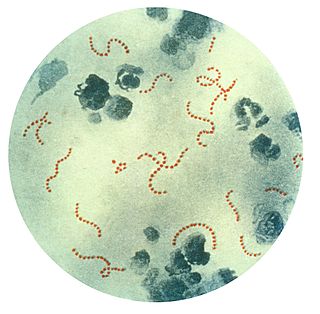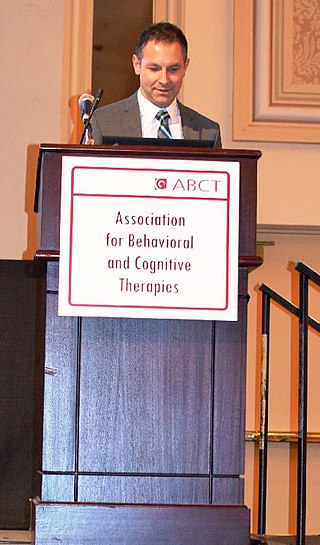Related Research Articles

Tourette syndrome or Tourette's syndrome is a common neurodevelopmental disorder that begins in childhood or adolescence. It is characterized by multiple movement (motor) tics and at least one vocal (phonic) tic. Common tics are blinking, coughing, throat clearing, sniffing, and facial movements. These are typically preceded by an unwanted urge or sensation in the affected muscles known as a premonitory urge, can sometimes be suppressed temporarily, and characteristically change in location, strength, and frequency. Tourette's is at the more severe end of a spectrum of tic disorders. The tics often go unnoticed by casual observers.

A tic is a sudden and repetitive motor movement or vocalization that is not rhythmic and involves discrete muscle groups. It is typically brief and may resemble a normal behavioral characteristic or gesture.

Pediatric Autoimmune Neuropsychiatric Disorders Associated with Streptococcal infections (PANDAS) is a diagnosis for a subset of children with rapid onset of obsessive-compulsive disorder (OCD) or tic disorders. Symptoms are proposed to be caused by group A streptococcal (GAS), and more specifically, group A beta-hemolytic streptococcal (GABHS) infections. OCD and tic disorders are hypothesized to arise in a subset of children as a result of a post-streptococcal autoimmune process. The proposed link between infection and these disorders is that an autoimmune reaction to infection produces antibodies that interfere with basal ganglia function, causing symptom exacerbations, and this autoimmune response results in a broad range of neuropsychiatric symptoms.
Stereotypic movement disorder (SMD) is a motor disorder with onset in childhood involving restrictive and/or repetitive, nonfunctional motor behavior, that markedly interferes with normal activities or results in bodily injury. To be classified as SMD, the behavior in question must not be due to the direct effects of a substance, autism, or another medical condition. The cause of this disorder is not known.
Tourette syndrome is an inherited neurodevelopmental disorder that begins in childhood or adolescence, characterized by the presence of motor and phonic tics. The management of Tourette syndrome has the goal of managing symptoms to achieve optimum functioning, rather than eliminating symptoms; not all persons with Tourette's require treatment, and there is no cure or universally effective medication. Explanation and reassurance alone are often sufficient treatment; education is an important part of any treatment plan.
Causes and origins of Tourette syndrome have not been fully elucidated. Tourette syndrome is an inherited neurodevelopmental disorder that begins in childhood or adolescence, characterized by the presence of multiple motor tics and at least one phonic tic, which characteristically wax and wane. Tourette's syndrome occurs along a spectrum of tic disorders, which includes transient tics and chronic tics.
Sensory phenomena are general feelings, urges or bodily sensations. They are present in many conditions including autism spectrum disorders, epilepsy, neuropathy, obsessive–compulsive disorder, pain conditions, tardive syndromes, and tic disorders.
Habit reversal training (HRT) is a "multicomponent behavioral treatment package originally developed to address a wide variety of repetitive behavior disorders".
The Yale–Brown Obsessive–Compulsive Scale (Y-BOCS) is a test to rate the severity of obsessive–compulsive disorder (OCD) symptoms.
The obsessive–compulsive spectrum is a model of medical classification where various psychiatric, neurological and/or medical conditions are described as existing on a spectrum of conditions related to obsessive–compulsive disorder (OCD). "The disorders are thought to lie on a spectrum from impulsive to compulsive where impulsivity is said to persist due to deficits in the ability to inhibit repetitive behavior with known negative consequences, while compulsivity persists as a consequence of deficits in recognizing completion of tasks." OCD is a mental disorder characterized by obsessions and/or compulsions. An obsession is defined as "a recurring thought, image, or urge that the individual cannot control". Compulsion can be described as a "ritualistic behavior that the person feels compelled to perform". The model suggests that many conditions overlap with OCD in symptomatic profile, demographics, family history, neurobiology, comorbidity, clinical course and response to various pharmacotherapies. Conditions described as being on the spectrum are sometimes referred to as obsessive–compulsive spectrum disorders.

Edna Foa is an Israeli professor of clinical psychology at the University of Pennsylvania, where she serves as the director of the Center for the Treatment and Study of Anxiety. Foa is an internationally renowned authority in the field of psychopathology and treatment of anxiety. She approaches the understanding and treatment of mental disorders from a cognitive-behavioral perspective.
Exposure therapy is a technique in behavior therapy to treat anxiety disorders. Exposure therapy involves exposing the patient to the anxiety source or its context. Doing so is thought to help them overcome their anxiety or distress. Numerous studies have demonstrated its effectiveness in the treatment of disorders such as generalized anxiety disorder (GAD), social anxiety disorder (SAD), obsessive-compulsive disorder (OCD), post-traumatic stress disorder (PTSD), and specific phobias.

Obsessive–compulsive disorder (OCD) is a mental and behavioral disorder in which an individual has intrusive thoughts and feels the need to perform certain routines (compulsions) repeatedly to relieve the distress caused by the obsession, to the extent where it impairs general function.
Susan Swedo is a researcher in the field of pediatrics and neuropsychiatry. Beginning in 1998, she was Chief of the Pediatrics & Developmental Neuroscience Branch at the US National Institute of Mental Health. In 1994, Swedo was lead author on a paper describing pediatric autoimmune neuropsychiatric disorders associated with streptococcal infections (PANDAS), a controversial hypothesis proposing a link between Group A streptococcal infection in children and some rapid-onset cases of obsessive-compulsive disorder (OCD) or tic disorders such as Tourette syndrome. Swedo retired from the NIH in 2019, and serves on the PANDAS Physician Network.
The cause of obsessive–compulsive disorder is understood mainly through identifying biological risk factors that lead to obsessive–compulsive disorder (OCD) symptomology. The leading hypotheses propose the involvement of the orbitofrontal cortex, basal ganglia, and/or the limbic system, with discoveries being made in the fields of neuroanatomy, neurochemistry, neuroimmunology, neurogenetics, and neuroethology.
James Frederick Leckman is an American child psychiatrist and psychoanalyst and the Neison Harris Professor of Child Psychiatry, Psychiatry, Psychology and Pediatrics at the Yale School of Medicine, recognized for his research in Tourette syndrome (TS) and obsessive–compulsive disorder (OCD).
The University of Florida Obsessive–Compulsive Disorder Program is a treatment and research clinic in the Department of Psychiatry at the University of Florida. The clinic is located in Gainesville, Florida.
The Yale Global Tic Severity Scale (YGTSS) is a psychological measure designed to assess the severity and frequency of symptoms of disorders such as tic disorder, Tourette syndrome, and obsessive-compulsive disorder, in children and adolescents between ages 6 and 17.

Jonathan Stuart Abramowitz is an American clinical psychologist and Professor in the Department of Psychology and Neuroscience at the University of North Carolina at Chapel Hill (UNC-CH). He is an expert on obsessive-compulsive disorder (OCD) and anxiety disorders whose work is highly cited. He maintains a research lab and currently serves as the Director of the UNC-CH Clinical Psychology PhD Program. Abramowitz approaches the understanding and treatment of psychological problems from a cognitive-behavioral perspective.
The Dimensional Obsessive-Compulsive Scale (DOCS) is a 20-item self-report instrument that assesses the severity of Obsessive-Compulsive Disorder (OCD) symptoms along four empirically supported theme-based dimensions: (a) contamination, (b) responsibility for harm and mistakes, (c) incompleteness/symmetry, and (d) unacceptable (taboo) thoughts. The scale was developed in 2010 by a team of experts on OCD led by Jonathan Abramowitz, PhD to improve upon existing OCD measures and advance the assessment and understanding of OCD. The DOCS contains four subscales that have been shown to have good reliability, validity, diagnostic sensitivity, and sensitivity to treatment effects in a variety of settings cross-culturally and in different languages. As such, the DOCS meets the needs of clinicians and researchers who wish to measure current OCD symptoms or assess changes in symptoms over time.
References
- 1 2 "UCLA Childhood OCD, Anxiety & Tic Disorders Program". UCLA Childhood OCD, Anxiety & Tic Disorders Program. Retrieved August 26, 2016.
- ↑ "Featured Team Member". UCLA Center for Child Anxiety, Resilience, Education and Support. Retrieved June 20, 2020.
- ↑ "Effective treatment for youth anxiety disorders has lasting benefit". www.sciencedaily.com. Retrieved August 18, 2016.
- ↑ McGuire JF, Murphy TK, Piacentini J, Storch EA, eds (2018). The Clinician’s Guide to Treatment and Management of Youth with Tourette Syndrome and Tic Disorders. Academic Press. ISBN 978-0128119808
- 1 2 "Scientific Advisory Board". The TLC Foundation. Retrieved June 21, 2020.
- ↑ Piacentini J, Peris TS, Bergman RL, Chang S, Jaffer M (2007). "Functional impairment in childhood OCD: development and psychometrics properties of the Child Obsessive-Compulsive Impact Scale-Revised (COIS-R)". J Clin Child Adolesc Psychol. 36 (4): 645–53. doi:10.1080/15374410701662790. PMID 18088221. S2CID 40489595.
- ↑ "Division 53 Division Fellows". www.clinicalchildpsychology.org. Archived from the original on August 20, 2016. Retrieved August 18, 2016.
- ↑ "Association for Psychological Science: APS Fellows". www.psychologicalscience.org. Archived from the original on June 25, 2017. Retrieved August 18, 2016.
- ↑ "Board of Trustees – 2020". American Board of Professional Psychology. Retrieved June 21, 2020.
- ↑ "TAA Behavior Sciences Consortium". Tourette Association of America. Retrieved June 21, 2020.
- ↑ "Anxiety and Depression: Personalized Treatments for Anxiety and Mood Disorders" (PDF). Anxiety and Depression Association of America. March 2014. Scientific Council, p. 101. Retrieved June 21, 2020.
- ↑ "2016 Annual Report" (PDF). International OCD Foundation. Scientific & Clinical Advisory Board, p. 25. Retrieved June 21, 2020.
